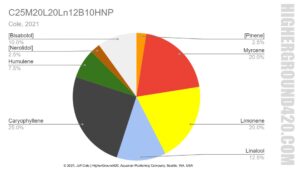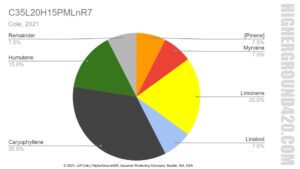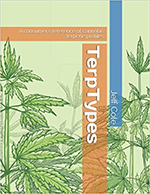Based on the book “TerpTypes: a consumer’s reference of Cannabis terpene profiles” (Jeff Cole, 2021).
Substitutions are nothing new. These substitutions were discovered in Commercially-produced Cannabis marketed by professional growers and sold to consumers. These Producers were proactive in that they wanted to help Science and learn what they could about their crops. The results were amazing!
Growers A and B

Grower A found that they were selling one profile under two strain names, Tahoe OG Kush and Skywalker OG Kush. (1) The Kush neighborhood is crowded, so this could be a case of identical profiles, but it is doubtful. Both samples were tested repeatedly and matched TerpType M35L25C17LnHPB (shown below).

Grower B is a large commercial grower with numerous strains in its nursery. From all of the terpene profiles run on their products, we observed that they had one substitution.
As it turns out, they had no idea. They acquired their strains years ago, thought they still had every clone properly identified, but one was lost along the way. It is reasonable to assume most substitutions happen at the seedling or clone stage. We speculate that at some point, a small plant was mislabeled and became the accepted source as the legitimate plant either died or was flowered-off and harvested.

The two plants in question for Grower B were OG Shark and Headband (in another garden they may be called something else). Both fit the TerpType C25M20L20Ln12B10HNP (shown above). This grower lost one at some point, but which? (2)
Branding, marketing, testing, labeling and the general expenses associated with a legitimate varietal are difficult enough without duplication. Producers growing either of these varieties with terpene results, are asked to please consider sharing them (link below). You can enter them yourself or send via email to [email protected].
Dispensary C

Dispensary C buys high-quality flower from members in their Medical Marijuana (MMJ) collective. They had two varieties, Venom OG and Rocket Fuel, with profiles so similar they wanted to find out which was which. One member may have substituted or just renamed their plant. Both varieties fit the TerpType C35L20H15PMLnR7 (shown below). (3)

Without questioning either grower’s integrity, now the dispensary’s management knows the two products are the same and may inform both growers. They may also choose to adjust their purchases and sales.
Dispensaries D through Z
Several dispensaries were shopped for commercially sold varieties and we found in the results that every dispensary (every location in several cities in California, Colorado and Washington) had at least one substitution. In some, over half of products sold were substitutions. None of these realized substitutions were so common. All of this was supported with DNA analysis. (4)
One of the least substituted varieties was Durban Poison. Growers know how easy it is to distinguish with huge leaves and long-fingered leaflets. On the bright side, consumers can be fairly confident in a Durban Poison purchase.
Together, many dispensaries and HigherGround420 are creating a reference by which we can all verify Cannabis varieties by TerpType. These DISPENSARIES and PRODUCERS support HigherGround420 with membership (subscriptions) and we support them with analysis, training, verification and certification.

Verify your strains
Growers, here’s how you can check your strains in the TerpType profiler at HigherGround420.com.
Carefully enter all quantified terpenes and other identifying data from a lab-certified cannabis test, including a link to the result pdf for verification (or send the pdf via email). Once verified, you’ll receive one free digital download of your HG420-Verified profile with all data visible. Use it on your label, website, anywhere.

(Login required, Subscribe HERE first – FREE Business Subscriptions O.K.)
HG420 prefers to handle the volume of verification not at the dispensary level, but by helping GROWERS obtain verification and certification. Please refer your growers to this article.

TerpTypes – a consumers reference of cannabis terpene profiles, by Jeff Cole (Copyright 2021); buy the book in the HG420 store. The terms “TerpType” and “TerpTypes” refer to the terpene profile expressed by a cannabis varietal and are Open Source terms. Please share with others; Education and Training available.
Click the links above for cannabis products with verified TerpTypes.
References:
- Fischedick, J. T. (2017). Identification of terpenoid chemotypes among high (−)-trans-Δ9-tetrahydrocannabinol-producing Cannabis sativa L. cultivars. Cannabis and cannabinoid research, 2(1), 34-47.
- Baron, E. P. (2018). Medicinal properties of cannabinoids, terpenes, and flavonoids in cannabis, and benefits in migraine, headache, and pain: an update on current evidence and cannabis science. Headache: The Journal of Head and Face Pain, 58(7), 1139-1186.
- Richins, R. D., Rodriguez-Uribe, L., Lowe, K., Ferral, R., & O’Connell, M. A. (2018). Accumulation of bioactive metabolites in cultivated medical Cannabis. PloS one, 13(7), e0201119.
- Schwabe, A. L., & McGlaughlin, M. E. (2019). Genetic tools weed out misconceptions of strain reliability in Cannabis sativa: implications for a budding industry. Journal of Cannabis Research, 1(1), 1-16. Full article online at https://jcannabisresearch.biomedcentral.com/articles/10.1186/s42238-019-0001-1.




